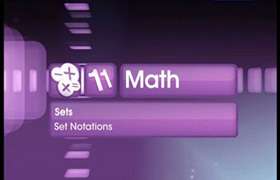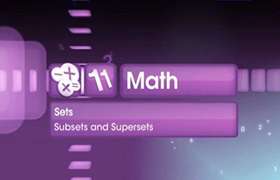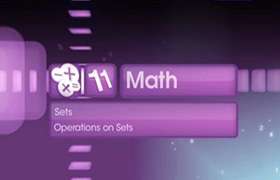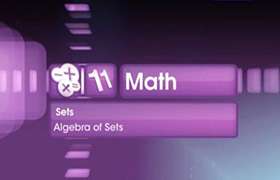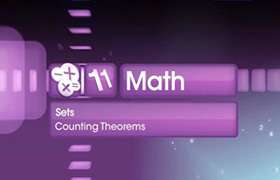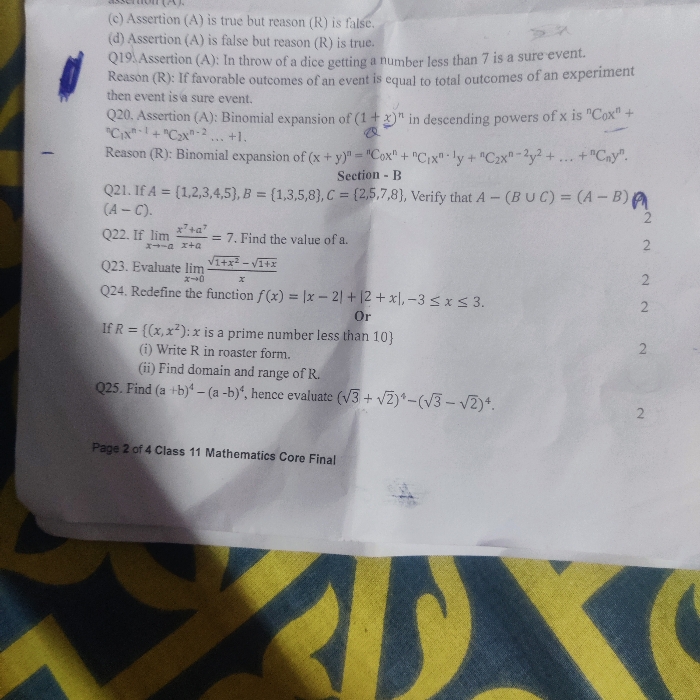CBSE Class 11-science Answered
in a town of 10000 families it was found that 40%families buy newspaper a,20% buy newspaper b and 10%buy newspaper c.5% families buy a and b.3% buy b and c and 4% buy a and c.if 2% buy all newspapers.find the number of families that buy
a only
b only
none of a,b and c
Asked by | 25 Feb, 2013, 10:04: AM
n(A) = 40% of 10,000 = 4,000
n(B) = 20% of 10,000 = 2,000
n(C) = 10% of 10,000 = 1,000
n (A  B) = 5% of 10,000 = 500
B) = 5% of 10,000 = 500
 B) = 5% of 10,000 = 500
B) = 5% of 10,000 = 500n (B  C) = 3% of 10,000 = 300
C) = 3% of 10,000 = 300
 C) = 3% of 10,000 = 300
C) = 3% of 10,000 = 300n(C  A) = 4% of 10,000 = 400,
A) = 4% of 10,000 = 400,
 A) = 4% of 10,000 = 400,
A) = 4% of 10,000 = 400,n(A  B
B  C) = 2% of 10,000 = 200
C) = 2% of 10,000 = 200
 B
B  C) = 2% of 10,000 = 200
C) = 2% of 10,000 = 200We want to find n(A only) = n(A) [n(A  B) + n(A
B) + n(A  C)] + n(A
C)] + n(A  B
B  C)=
C)=
 B) + n(A
B) + n(A  C)] + n(A
C)] + n(A  B
B  C)=
C)= n(A only) = 4000 [500 + 400] + 200 = 4000 700 = 3300
Similarly, n(B only) = n(B) [n(A  B) + n(B
B) + n(B C)] + n(A
C)] + n(A  B
B  C)
C)
 B) + n(B
B) + n(B C)] + n(A
C)] + n(A  B
B  C)
C)n(B only) = 2000 - [500+300]+200 = 1400
n(none of A, B and C) = 10,000 - [n(A)+n(B) + n(C) - n (A  B) - n(B
B) - n(B C) - n (C
C) - n (C A) + n(A
A) + n(A B
B C)]
C)]
 B) - n(B
B) - n(B C) - n (C
C) - n (C A) + n(A
A) + n(A B
B C)]
C)]n(none of A, B and C) = 10,000 - [4000+2000+1000 - 500-300-400 + 200]
n(none of A, B and C) = 4000
Answered by | 25 Feb, 2013, 06:28: PM
Concept Videos
CBSE 11-science - Maths
Asked by parvanipatil09 | 29 Mar, 2024, 10:12: AM
CBSE 11-science - Maths
Asked by divyanshtikkiwal6 | 23 Feb, 2024, 07:44: PM
CBSE 11-science - Maths
Asked by pranavsrinivas82 | 14 Jan, 2024, 07:45: AM
CBSE 11-science - Maths
Asked by pranavsrinivas82 | 10 Jan, 2024, 08:45: PM
CBSE 11-science - Maths
Asked by naiduuofficial | 06 Jan, 2023, 07:49: PM
CBSE 11-science - Maths
Asked by anjaneyagadgil04 | 05 Jan, 2023, 12:16: PM
CBSE 11-science - Maths
Asked by bangtan7hybe | 18 Sep, 2022, 06:36: PM
CBSE 11-science - Maths
Asked by kdimple765 | 24 Jun, 2022, 04:22: PM
CBSE 11-science - Maths
Asked by arjunsah797 | 03 Mar, 2022, 06:04: PM
CBSE 11-science - Maths
Asked by krishkhare04 | 03 Feb, 2022, 02:35: PM

